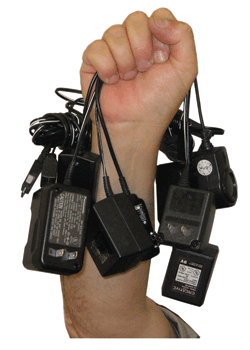Power to the people’s portables
Why is it that the busier you get, the more likely it is that small, stupid things that get in the way of your progress are likely to really annoy you?
This happened to me the other day while I was trying to multitask. I decided to recharge my phone and Bluetooth headset while I was busy working at my computer. I have a power strip on my desktop, and I tried to plug in the rechargers for both devices simultaneously.

The power strip has six ac outlets on it, and I normally have two things plugged into it: an ac/dc converter to power my computer speakers, as well as a desk lamp. So that leaves four outlets free for me to plug in the two rechargers. No problem, right?
Wrong! The problem was that each converter/recharger actually takes up three outlet spaces on the strip, even though they are of different designs. One is a boxy unit that is so wide it makes it impossible to plug in a normal American-style two-prong plug on either side of it, much less a grounded three-prong plug. The other rechargers are of a narrower style that may work OK in a wall socket, but in a strip it fully covers an adjoining outlet unless it is placed at the end of the strip; then it only makes it impossible to plug in to the receptacle on its other side.
It seems to me that it’s about time for industry to set some sensible standards for recharging portable devices.
I’ve only run into this problem with rechargers for small portable devices. Laptop makers seem to have thought this out and provide a length of cord with a regular ac plug that doesn’t interfere with other sockets. Apple laptops offer users the option of using a special ac-cord extension or plugging the converter/recharger box directly into a socket.
Compounding my annoyance is the fact that I have to carry around separate rechargers for each portable devices I own. Apparently, each manufacturer decided it was necessary for the portable device’s power-input connectors to have a unique configuration, for what reason I cannot fathom.
It seems to me that it’s about time for industry to set some sensible standards for recharging portable devices. Obviously, this would be a benefit to consumers, who wouldn’t have to lug around a bagful of converters. (And leave them behind at hotels; I once saw a carton filled with rechargers when I asked a concierge if he could supply one.)
But it would also benefit manufacturers as well. They would only need to supply the rechargeable device, and could thus keep the retail price lower (and profit higher). And a separate market in rechargers would be created that could actually innovate within the connection standards, providing, say, greater power efficiency and better physical design.
Albeit the current situation is not earth shattering. I was able to rearrange the way things were plugged into the strip so that I could actually get all four things to function at the same time, although there was no way to use the other two sockets. Still, it is in the nature of engineering to want a better mousetrap, even if mice are small problems.
Richard Comerford
Advertisement
Learn more about Electronic Products Magazine





